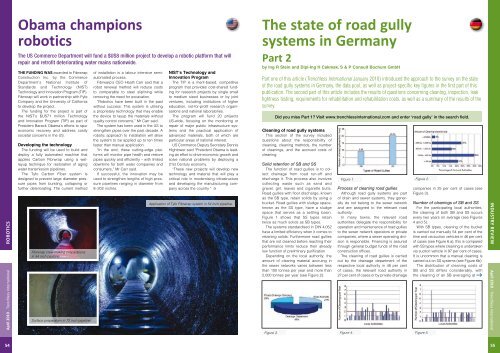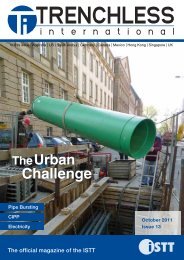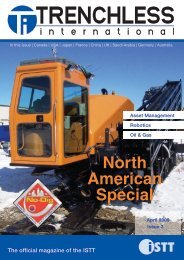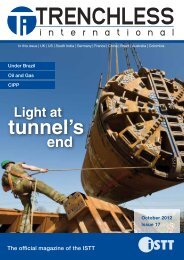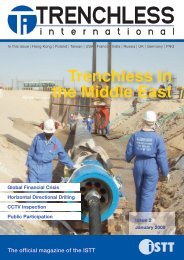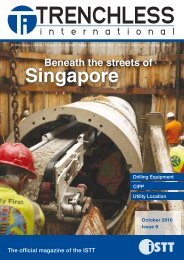Boring - Trenchless International
Boring - Trenchless International
Boring - Trenchless International
You also want an ePaper? Increase the reach of your titles
YUMPU automatically turns print PDFs into web optimized ePapers that Google loves.
Robotics<br />
April 2010 - <strong>Trenchless</strong> <strong>International</strong><br />
Obama champions<br />
robotics<br />
The US Commerce Department will fund a $US8 million project to develop a robotic platform that will<br />
repair and retrofit deteriorating water mains nationwide.<br />
The funding was awarded to Fibrwrap<br />
Construction Inc. by the Commerce<br />
Department’s National Institute of<br />
Standards and Technology (NIST)<br />
Technology and Innovation Program (TIP).<br />
Fibrwrap will work in partnership with Fyfe<br />
Company and the University of California<br />
to develop the project.<br />
The funding for the project is part of<br />
the NIST’s $US71 million Technology<br />
and Innovation Program (TIP) as part of<br />
President Barack Obama’s efforts to spur<br />
economic recovery and address costly<br />
societal concerns in the US.<br />
Developing the technology<br />
The funding will be used to build and<br />
deploy a fully automated machine that<br />
applies Carbon Fibrwrap using a wetlayup<br />
technique for restoration of aging<br />
water transmission pipelines.<br />
The Tyfo Carbon Fiber system is<br />
designed to prevent large diameter pressure<br />
pipes from bursting, collapsing or<br />
further deteriorating. The current method<br />
Fibrwrap crew making preparations<br />
in 54 inch pipeline.<br />
Surface preparation in 72 inch pipeline.<br />
of installation is a labour intensive semiautomated<br />
process.<br />
Fibrwarp’s CEO Heath Carr said that a<br />
robot renewal method will reduce costs<br />
to comparable to steel sliplining while<br />
removing the need for excavation.<br />
“Robotics have been built in the past<br />
without success. This system is utilising<br />
a proprietary technology that may enable<br />
the device to layup the materials without<br />
quality control concerns,” Mr Carr said.<br />
The system has been used in the US to<br />
strengthen pipes over the past decade. A<br />
robotic approach to installation will allow<br />
the system to be applied up to ten times<br />
faster than manual application.<br />
“In the end, these cutting-edge platforms<br />
will monitor pipe health and restore<br />
pipes quickly and efficiently – with limited<br />
downtime for both water companies and<br />
consumers,” Mr Carr said.<br />
If successful, the innovation may be<br />
used to strengthen lengths of high pressure<br />
pipelines ranging in diameter from<br />
8–202 inches.<br />
NIST’s Technology and<br />
Innovation Program<br />
The TIP is a merit-based, competitive<br />
program that provides cost-shared funding<br />
for research projects by single small<br />
to medium sized businesses or by joint<br />
ventures, including institutions of higher<br />
education, not-for-profit research organisations<br />
and national laboratories.<br />
The program will fund 20 projects<br />
US-wide, focusing on the monitoring or<br />
repair of major public infrastructure systems<br />
and the practical application of<br />
advanced materials, both of which are<br />
particular areas of national interest.<br />
US Commerce Deputy Secretary Dennis<br />
Hightower said “President Obama is leading<br />
an effort to drive economic growth and<br />
solve national problems by deploying a<br />
21st Century economy.<br />
“These new projects will develop new<br />
technology and material that will play a<br />
critical role in modernising infrastructure<br />
and developing the manufacturing company<br />
across the country.”<br />
Application of Tyfo Fibrwrap system in 54 inch pipeline.<br />
The state of road gully<br />
systems in Germany<br />
Part 2<br />
by Ing R Stein and Dipl-Ing H Cakmak, S & P Consult Bochum GmbH<br />
Part one of this article (<strong>Trenchless</strong> <strong>International</strong> January 2010) introduced the approach to the survey on the state<br />
of the road gully systems in Germany, the data pool, as well as project-specific key figures in the first part of this<br />
publication. The second part of this article includes the results of questions concerning cleaning, inspection, leak<br />
tightness testing, requirements for rehabilitation and rehabilitation costs, as well as a summary of the results of the<br />
survey.<br />
Did you miss Part 1? Visit www.trenchlessinternational.com and enter ‘road gully’ in the search field.<br />
Cleaning of road gully systems<br />
This section of the survey included<br />
questions about the responsibility of<br />
cleaning, cleaning methods, the number<br />
of cleanings, and the accrued costs of<br />
cleaning.<br />
Solid retention of SB and SS<br />
The function of road gullies is to collect<br />
drainage from road run-off and<br />
discharge it. This process also involves<br />
collecting waste such as sand and<br />
gravel, grit, leaves and cigarette butts.<br />
Road gullies with floor discharge, known<br />
as the SB type, retain solids by using a<br />
bucket. Road gullies with sludge space,<br />
known as the SS type, have a sludge<br />
space that serves as a settling basin.<br />
Figure 1 shows that SS types retain<br />
twice as much solids as SB types.<br />
The systems standardised in DIN 4,052<br />
have a limited efficiency when it comes to<br />
retaining solids. Furthermore road gullies<br />
that are not cleaned before reaching their<br />
performance limits reduce their already<br />
low function of preliminary purification.<br />
Depending on the local authority, the<br />
amount of clearing material accruing in<br />
the sewer networks varies between less<br />
than 100 tonnes per year and more than<br />
5,000 tonnes per year (see Figure 2).<br />
Figure 1. Figure 2.<br />
Process of cleaning road gullies<br />
Although road gully systems are part<br />
of drain and sewer systems, they generally<br />
do not belong to the sewer network<br />
and are assigned to the relevant road<br />
authority.<br />
In many towns, the relevant road<br />
authorities delegate the responsibility for<br />
operation and maintenance of road gullies<br />
to the sewer network operators or private<br />
companies, where a sewer operating division<br />
is responsible. Financing is assured<br />
through general budget funds of the road<br />
construction offices.<br />
The cleaning of road gullies is carried<br />
out by the drainage department of the<br />
respective local authority in 48 per cent<br />
of cases, the relevant road authority in<br />
27 per cent of cases or by private drainage<br />
Figure 3. Figure 4. Figure 5.<br />
companies in 25 per cent of cases (see<br />
Figure 3).<br />
Number of cleanings of SB and SS<br />
For the participating local authorities,<br />
the cleaning of both SB and SS occurs<br />
every two years on average (see Figures<br />
4 and 5).<br />
With SB types, cleaning of the bucket<br />
is carried out manually 54 per cent of the<br />
time and via suction vehicles in 46 per cent<br />
of cases (see Figure 6.a), this is compared<br />
with SS types where cleaning is undertaken<br />
via suction vehicle in 97 per cent of cases.<br />
It is uncommon that a manual cleaning is<br />
carried out on SS systems (see Figure 6b).<br />
The distribution of cleaning costs of<br />
SB and SS differs considerably, with<br />
the cleaning of an SB averaging at<br />
industry review<br />
April 2010 - <strong>Trenchless</strong> <strong>International</strong><br />
54<br />
55


